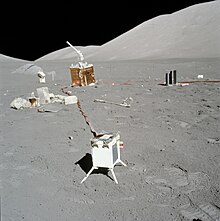
Explorer 35,, was a spin-stabilized spacecraft built by NASA as part of the Explorer program. It was designed for the study of the interplanetary plasma, magnetic field, energetic particles, and solar X-rays, from lunar orbit.

IMAGE is a NASA Medium Explorer mission that studied the global response of the Earth's magnetosphere to changes in the solar wind. It was believed lost but as of August 2018 might be recoverable. It was launched 25 March 2000, at 20:34:43.929 UTC, by a Delta II launch vehicle from Vandenberg Air Force Base on a two-year mission. Almost six years later, it unexpectedly ceased operations in December 2005 during its extended mission and was declared lost. The spacecraft was part of NASA's Sun-Earth Connections Program, and its data has been used in over 400 research articles published in peer-reviewed journals. It had special cameras that provided various breakthroughs in understanding the dynamics of plasma around the Earth. The principal investigator was Jim Burch of the Southwest Research Institute.

Explorer 33, also known as IMP-D and AIMP-1, is a spacecraft in the Explorer program launched by NASA on 1 July 1966 on a mission of scientific exploration. It was the fourth satellite launched as part of the Interplanetary Monitoring Platform series, and the first of two "Anchored IMP" spacecraft to study the environment around Earth at lunar distances, aiding the Apollo program. It marked a departure in design from its predecessors, IMP-A through IMP-C. Explorer 35 was the companion spacecraft to Explorer 33 in the Anchored IMP program, but Explorer 34 (IMP-F) was the next spacecraft to fly, launching about two months before AIMP-E, both in 1967.

Lunar soil is the fine fraction of lunar regolith found on the surface of the Moon and contributes to the Moon's tenuous atmosphere. Lunar soil differs in its origin and properties significantly from terrestrial soil.

Energetic Neutral Atom (ENA) imaging, often described as "seeing with atoms", is a technology used to create global images of otherwise invisible phenomena in the magnetospheres of planets and throughout the heliosphere.
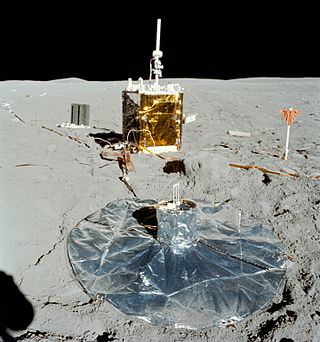
The Apollo Lunar Surface Experiments Package (ALSEP) comprised a set of scientific instruments placed by the astronauts at the landing site of each of the five Apollo missions to land on the Moon following Apollo 11. Apollo 11 left a smaller package called the Early Apollo Scientific Experiments Package, or EASEP.

The ISEE-1 was an Explorer-class mother spacecraft, International Sun-Earth Explorer-1, was part of the mother/daughter/heliocentric mission. ISEE-1 was a 340.2 kg (750 lb) space probe used to study magnetic fields near the Earth. ISEE-1 was a spin-stabilized spacecraft and based on the design of the prior IMP series of spacecraft. ISEE-1 and ISEE-2 were launched on 22 October 1977, and they re-entered on 26 September 1987.
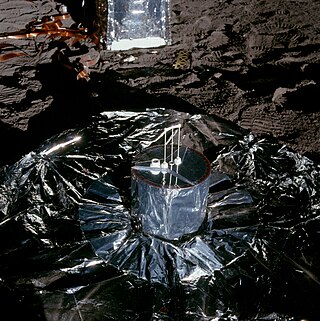
The Apollo 12 Passive Seismic Experiment (PSE) was placed on the lunar surface by the Apollo 12 mission as part of the Apollo Lunar Surface Experiments Package (ALSEP). The PSE was designed to detect vibrations and tilting of the lunar surface and measure changes in gravity at the instrument location. The vibrations are due to internal seismic sources (moonquakes) and external. The primary objective of the experiment was to use these data to determine the internal structure, physical state, and tectonic activity of the Moon. The secondary objectives were to determine the number and mass of meteoroids that strike the Moon and record tidal deformations of the lunar surface.

The Apollo 14 Passive Seismic Experiment (PSE) was placed on the lunar surface on February 5, 1971, as part of the Apollo 14 ALSEP package. The PSE was designed to detect vibrations and tilting of the lunar surface and measure changes in gravity at the instrument location. The vibrations are due to internal seismic sources (moonquakes) and external. The primary objective of the experiment was to use these data to determine the internal structure, physical state, and tectonic activity of the Moon. The secondary objectives were to determine the number and mass of meteoroids that strike the Moon and record tidal deformations of the lunar surface.
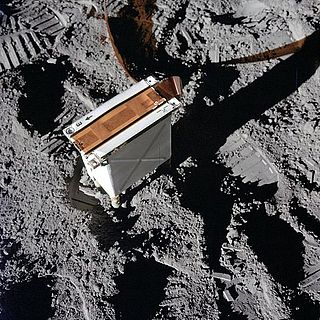
The Charged Particle Lunar Environment Experiment (CPLEE), placed on the lunar surface by the Apollo 14 mission as part of the Apollo Lunar Surface Experiments Package (ALSEP), was designed to measure the energy spectra of low-energy charged particles striking the lunar surface. It measured the fluxes of electrons and ions with energies from 40 eV to 20 keV. The primary purpose of the experiment was to examine plasma particles originating from the Sun and the low-energy particle flux in the Earth's magnetic tail.

The Interstellar Mapping and Acceleration Probe(IMAP) is a heliophysics mission that will simultaneously investigate two important and coupled science topics in the heliosphere: the acceleration of energetic particles and interaction of the solar wind with the local interstellar medium. These science topics are coupled because particles accelerated in the inner heliosphere play crucial roles in the outer heliospheric interaction. In 2018, NASA selected a team led by David J. McComas of Princeton University to implement the mission, which is currently planned to launch in February 2025. IMAP will be a Sun-tracking spin-stabilized satellite in orbit about the Sun–Earth L1 Lagrange point with a science payload of ten instruments. IMAP will also continuously broadcast real-time in-situ data that can be used for space weather prediction.

Explorer 43, also called as IMP-I and IMP-6, was a NASA satellite launched as part of Explorer program. Explorer 43 was launched on 13 March 1971 from Cape Canaveral Air Force Station (CCAFS), with a Thor-Delta M6 launch vehicle. Explorer 43 was the sixth satellite of the Interplanetary Monitoring Platform.
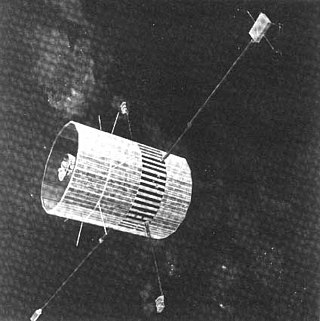
Explorer 47, was a NASA satellite launched as part of Explorer program. Explorer 47 was launched on 23 September 1972 from Cape Canaveral, Florida, with a Thor-Delta 1604. Explorer 47 was the ninth overall launch of the Interplanetary Monitoring Platform series, but received the launch designation "IMP-7" because two previous "Anchored IMP" flights had used "AIMP" instead.

Dynamics Explorer 1 was a NASA high-altitude mission, launched on 3 August 1981, and terminated on 28 February 1991. It consisted of two satellites, DE-1 and DE-2, whose purpose was to investigate the interactions between plasmas in the magnetosphere and those in the ionosphere. The two satellites were launched together into polar coplanar orbits, which allowed them to simultaneously observe the upper and lower parts of the atmosphere.

Dynamics Explorer 2 was a NASA low-altitude mission, launched on 3 August 1981. It consisted of two satellites, DE-1 and DE-2, whose purpose was to investigate the interactions between plasmas in the magnetosphere and those in the ionosphere. The two satellites were launched together into polar coplanar orbits, which allowed them to simultaneously observe the upper and lower parts of the atmosphere.
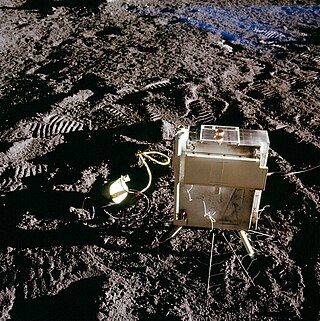
The Cold Cathode Gauge Experiment, also known as the Lunar Atmosphere Detector, was a scientific package that flew on board Apollo 12, Apollo 13, Apollo 14, and Apollo 15. The goal of the experiment was to measure the density of the Moon's tenuous atmosphere, but not its composition.
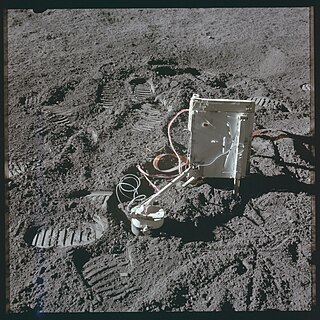
The Suprathermal Ion Detector Experiment (SIDE) was a lunar science experiment, deployed by astronauts on the lunar surface as part of Apollo 12, Apollo 14 and Apollo 15. The goal of SIDE was to study any potential lunar ionosphere and the solar wind.

Space dust measurement refers to the study of small particles of extraterrestrial material, known as micrometeoroids or interplanetary dust particles (IDPs), that are present in the Solar System. These particles are typically of micrometer to sub-millimeter size and are composed of a variety of materials including silicates, metals, and carbon compounds. The study of space dust is important as it provides insight into the composition and evolution of the Solar System, as well as the potential hazards posed by these particles to spacecraft and other space-borne assets. The measurement of space dust requires the use of advanced scientific techniques such as secondary ion mass spectrometry (SIMS), optical and atomic force microscopy (AFM), and laser-induced breakdown spectroscopy (LIBS) to accurately characterize the physical and chemical properties of these particles.

The Solar Wind Spectrometer was a scientific package that flew on the Apollo 12 and Apollo 15 missions to the surface of the Moon. The goal was to characterise the solar wind near the Moon's surface and to explore its interactions with the lunar environment. The experiments' principal investigator was Dr Conway W. Snyder of the Jet Propulsion Laboratory.
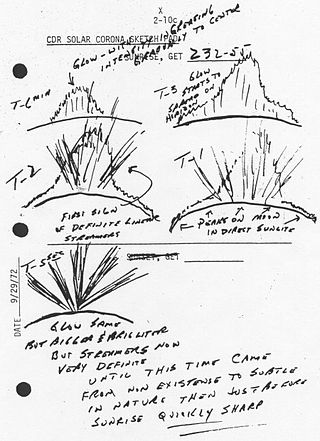
Lunar horizon glow is a phenomenon due to which dust particles on the Moon's thin Atmosphere create a glow during lunar sunset. The Surveyor program provided data and photos of the phenomenon, Astronauts in the Apollo 15, and Apollo 17 missions observed them while in lunar orbit.
